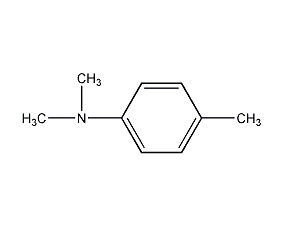
Structural formula
| Business number | 02GW |
|---|---|
| Molecular formula | C9H13N |
| Molecular weight | 135.21 |
| label |
4-Dimethylaminotoluene, N,N,4-Trimethylaniline, N,N-dimethyl-p-toluidine, 4-Dimethylaminotoluene, dimethyl p-toluidine, p-dimethylaminotoluene, dimethyltoluidine, Trimethylaniline, CH3C6H4N(CH3)2, N,N,4-Trimethylbenzenamine, N,N-Dimethyl-4-methylaniline, N,N-Dimethyl-4-toluidine, N,N-Dimethyl-para-toluidine, N,N-Dimethyl-p-toluidine, Benzeneamine,N,N,4-trimethyl-, Dimethyl-4-toluidine, Dimethyl-p-toluidine |
Numbering system
CAS number:99-97-8
MDL number:MFCD00008316
EINECS number:202-805-4
RTECS number:XU5803000
BRN number:774409
PubChem number:24866113
Physical property data
1. Properties: light yellow liquid.
2. Density (g/mL, 25℃): 0.937
3. Relative vapor density (g/mL, air=1): >1
4. Melting point (ºC): -25
5. Boiling point (ºC, normal pressure): 211
6. Boiling point (ºC, 45mmHg): Undetermined
7. Refractive index: 1.546
8. Flash point (ºC): 83
9. Specific rotation (º): Undetermined
10. Autoignition point or ignition temperature (ºC): Not determined
11. Vapor pressure (mmHg, ºC): Not determined
12. Saturated vapor pressure (kPa, ºC) : Undetermined
13. Heat of combustion (KJ/mol): Undetermined
14. Critical temperature (ºC): Undetermined
15. Critical pressure (KPa): Undetermined
16. Log value of oil-water (octanol/water) partition coefficient: Undetermined
17. Explosion upper limit (%, V/V): Undetermined Determined
18. Lower explosion limit (%, V/V): Undetermined
19. Solubility: Undetermined
Toxicological data
1. Acute toxicity: mouse peritoneal cavity LD50: 212mg/kg; 2. Mutagenicity: DNA damage Oral test: rat, 1082mg/kg;DNA damage peritoneal cavity test: rat, 541mg/kg; DNA damage peritoneal cavity test: mouse, 135mg/kg; Micronucleus test: hamster lung, 900μmol/L;
Acute toxicity:
Inhalation LC50/4H 1400mg/m3/4H (rat)
Main irritating effects:
On the skin: Irritating the skin and mucous membranes.
On eyes: Irritation effects
Sensitization: No known sensitizing effects.
Ecological data
General remarks
Water hazard level 3 (German regulations) (self-assessment via list) This substance is extremely hazardous to water.
Do not allow this product to come into contact with groundwater, waterways or sewage systems, even in small amounts.
Even small amounts of product seeping into the ground can pose a hazard to drinking water
Do not discharge materials into the surrounding environment without government permission.
Toxic to organic matter in water.
Molecular structure data
1. Molar refractive index: 45.39
2. Molar volume (cm3/mol): 143.6
3. Isotonic specific volume (90.2K ): 346.9
4. Surface tension (dyne/cm): 33.9
5. Dielectric constant:
6. Dipole moment (10-24cm3):
7. Polarizability: 17.99
Compute chemical data
1. Reference value for hydrophobic parameter calculation (XlogP): None
2. Number of hydrogen bond donors: 0
3. Number of hydrogen bond acceptors: 1
4. Number of rotatable chemical bonds: 1
5. Number of tautomers: none
6. Topological molecule polar surface area 3.2
7. Number of heavy atoms: 10
8. Surface charge: 0
9. Complexity: 90.9
10. Number of isotope atoms: 0
11. Determine the number of atomic stereocenters: 0
12. Uncertain number of atomic stereocenters: 0
13. Determine the number of chemical bond stereocenters: 0
14. Number of uncertain chemical bond stereocenters: 0
15. Number of covalent bond units: 1
Properties and stability
Avoid contact with strong oxidants, acids, acid anhydrides, and acidic chlorides.
Storage method
Store in a cool, ventilated warehouse. Keep away from fire and heat sources. Keep container tightly sealed. They should be stored separately from oxidants, acidic substances, acid anhydrides, acid chlorides, and food chemicals, and avoid mixed storage. Equipped with the appropriate variety and quantity of fire equipment. Suitable materials should be available in the storage area to contain spills.
Synthesis method
None yet
Purpose
Used to make self-setting dental tray water


